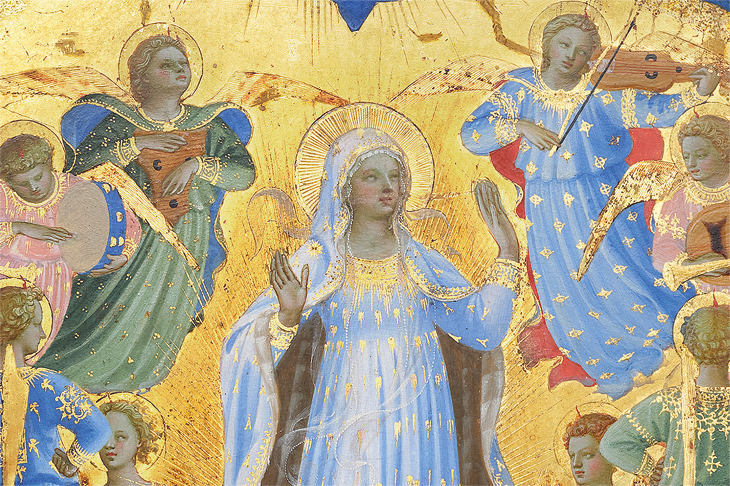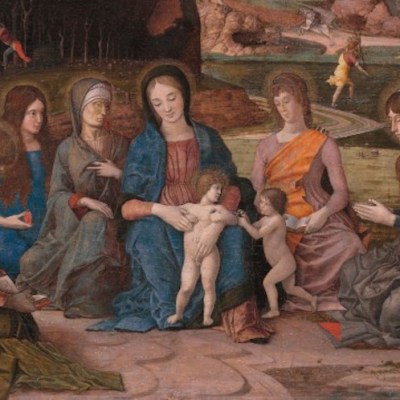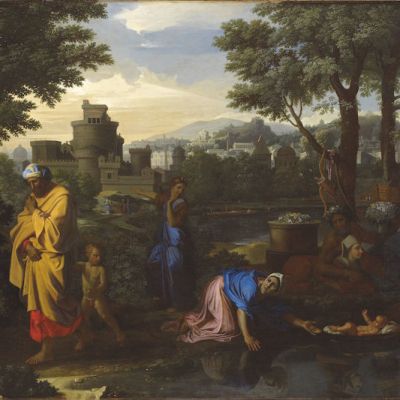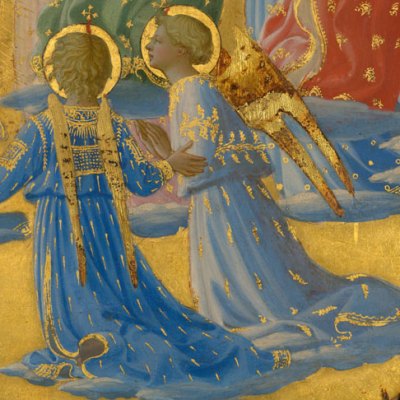In the decade between 1424 and 1434, the painter Guido di Pietro, who a few years earlier had joined the Dominican order as Fra Giovanni da Fiesole and is better known today as Fra Angelico, painted four exquisite reliquaries for the sacristy of Santa Maria Novella. Giovanni di Zanobi Masi, the sacristan of the Florentine church, was the patron of the four tabernaculetti. The four objects, designed following a typically Sienese format, were created to hold relics in their frames, and were decorated with Marian subject matters: the Annunciation and the Adoration of the Magi, the Coronation of the Virgin, the Dormition and Assumption of the Virgin and the Madonna della Stella. After residing in Santa Maria Novella for centuries, these four paintings were separated in the second half of the 19th century. Three of them were transferred to the newly created Museo di San Marco in Florence in 1868, while the fourth, the Dormition and Assumption of the Virgin, reached first England in 1816 and then the United States at the end of the century; it was the first work by Fra Angelico to cross the Atlantic Ocean.
The Annunciation and The Adoration of the Virgin (left) and The Coronation of the Virgin (right) (1424–34), Fra Angelico. Museo di San Marco, Florence Photos: Restauro Dipinti Studio 4
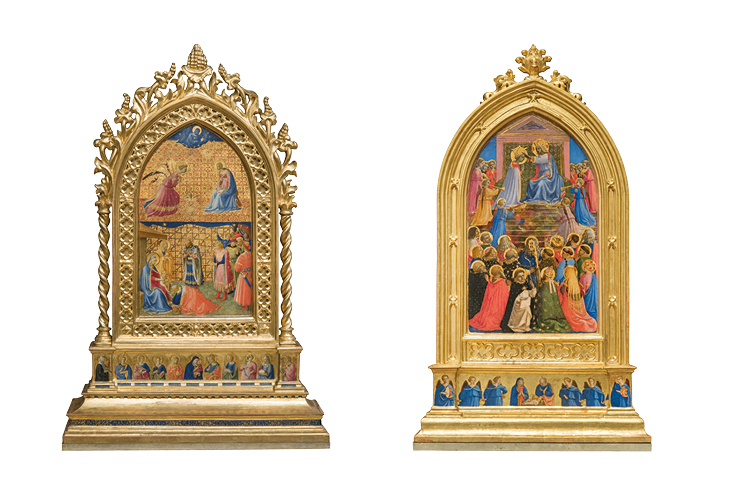
This fourth reliquary from Santa Maria Novella was purchased by Isabella Stewart Gardner in 1899. She was following the advice of Bernard Berenson, who had described the work to her in a letter of 20 December 1898 as ‘one of the loveliest ever painted. All that deep and sweet sentiment and great qualities of art can do to make a picture gracious and beautiful has been done here.’ It seems appropriate that the four reliquaries by Fra Angelico should be reunited for the first time since the 19th century at the Isabella Stewart Gardner Museum in Boston. A medieval rotunda with gothic arches, inspired by the architecture of Santa Maria Novella, has been raised in the middle of the museum’s exhibition space at Fenway Court, and in it the four reliquaries shine. The design of the exhibition skilfully evokes how these reliquaries would have been displayed in Florence, a display that traditionally occurred only on religious feast days.
The Boston reliquary is not only a perfect example of Angelico’s art, but also one that has survived in almost pristine condition. In 1857 the German art historian Gustav Friedrich Waagen described the painting, at the time in the English collection of Baron Methuen, as ‘one of the most admirable works I know of the master, and at the same time in marvellous preservation’. Its painted surface (unfortunately without its original frame) is miraculously intact. The effervescent colours of most of the paintings in the show contrast beautifully with the gilding, highly decorated with repeating patterns that make the gold pulsate under different light sources. John Pope-Hennessy wrote of ‘a golden thread of faith’ running through the paintings of Fra Angelico. Few painters in Renaissance Italy used gold to such dazzling effect. In this handsomely lit and peaceful space, it is possible to admire Angelico’s works under ideal conditions.
The Dormition and Assumption of the Virgin (left) and The Madonna della Stella (right) (1424–34), Fra Angelico. Isabella Stewart Gardner Museum, Boston/Museo di San Marco, Florence. Photos: David Mathews/Restauro Dipinti Studio 4
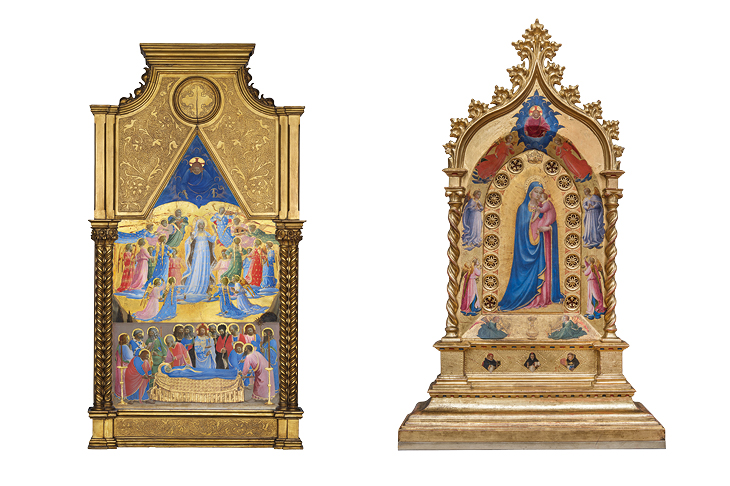
The curator of the exhibition, Nathaniel Silver, did not simply seek to reunite the four reliquaries. He presents them as part of a tight group of 13 works (12 paintings and a drawing) by Fra Angelico in Italian and American public collections, which makes us look at the artist in an altogether fresh way. It is easy to dismiss Fra Angelico as a painter of sentimental, religious images, akin to those that appear in Catholic santini and pamphlets for baptisms and first communions. He was, in fact, a sophisticated artist, who produced refined religious imagery, from large altarpieces to small devotional paintings. He was also a painter of astounding fresco cycles, producing works for the convent of San Marco, for the cathedral in Orvieto, and for the papal palace in Rome. The Niccoline Chapel in the Vatican has the misfortune of often being overlooked for Michelangelo’s more ambitious yet less elegant papal chapels, the Sistine and Pauline. The exhibition in Boston focuses on Angelico as a narrative painter. It includes a small altarpiece (a sadly damaged Entombment from Washington) and a triptych (from Palazzo Corsini in Rome), predella panels (from the Annalena altarpiece), and even one of the painted cupboard doors of a chest for silver (the Armadio degli Argenti) for the church of the Santissima Annunziata. The spectacular small Paradise altarpiece painted for Sant’Egidio, and now at the Uffizi, is reunited with its predella, now slightly less than a mile away in Florence in the Museo di San Marco.
The exhibition highlights Angelico’s profound pictorial intelligence. A painter who trained as an illuminator, he never shed his taste for refinement and intimacy, providing quiet spiritual chronicles, which still enchant the viewer if given the attention they deserve. The accompanying catalogue is a scholarly but accessible and thought-provoking exercise. It is a taut and concentrated study of the painter, focusing on the reliquaries, but also examining broader issues concerning the artist and Dominican patronage. It is full of significant, and often new, information, including important technical analysis.
It is good to see that the career of an important Renaissance artist can be successfully explored in an exhibition of 13 works, and that this approach can be more successful than blockbusters with almost 250 works. The staff at the Isabella Stewart Gardner Museum, like its founder, have long understood that quality is always more rewarding than quantity.
‘Fra Angelico: Heaven on Earth’ is at the Isabella Stewart Gardner Museum, Boston, until 20 May.
From the May issue of Apollo. Preview and subscribe here.
